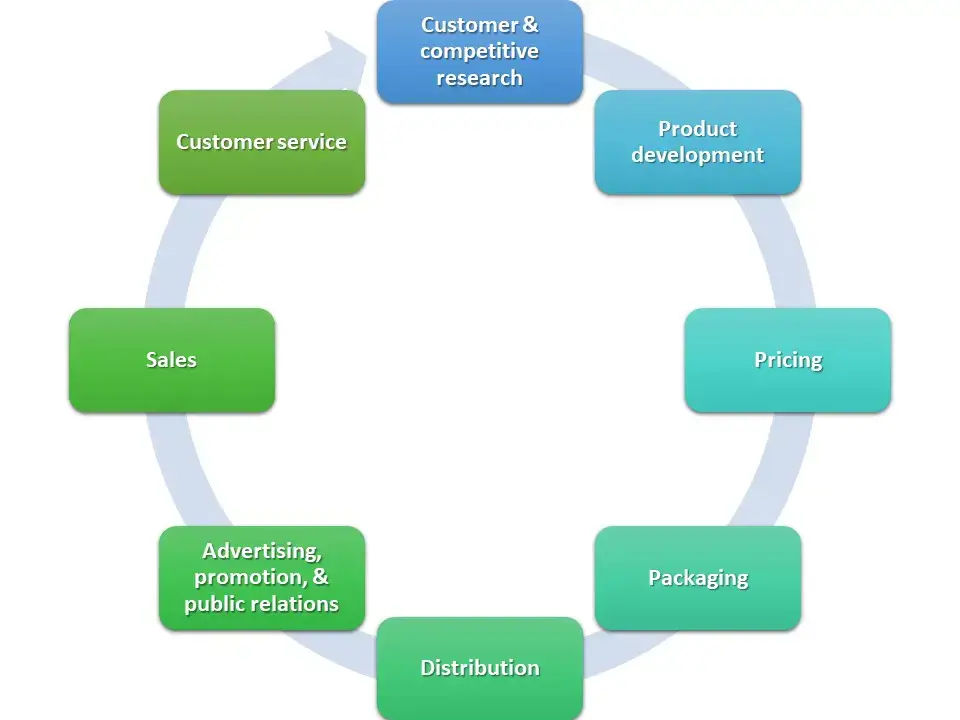Back to blog
7 MIN READ
Go-To-Market Strategy in Product Management: Guide + Checklist
PUBLISHED
30 November, 2023

Product Analytics Expert
Taking a new product to market is no easy feat. All the ingredients need to be right—from the ICP to the pricing, messaging, and sales process.
Your go-to-market (GTM) strategy is one of the most critical pieces of the puzzle. A successful GTM strategy should capture your customer’s attention, help you develop a strong brand presence, and set you up to close deals.
In this UXCam guide, we will explore the importance of GTM strategies and offer a battle-tested checklist that will help you succeed in launching a product.
Let’s dive in.
What is a go-to-market strategy?
A go-to-market (GTM) strategy is a comprehensive plan that outlines how an organization will sell its products or services to customers. It details how the organization can engage with customers to convince them to buy their product or service and to gain a competitive advantage.

A typical software or app GTM strategy includes tactics related to:
Pricing
Customer intelligence
Distribution channels
Sales & marketing plans
Promotional activities
It’s designed to mitigate the risk inherent in the introduction of a new product and includes target market profiles, a marketing plan, and a concrete sales strategy.
Advantages of a go-to-market strategy
Keep you focused
A GTM strategy helps product managers stay focused on the end goal. It provides a clear roadmap that outlines the steps needed to successfully launch a product. This can help product managers avoid distractions and make sure that all efforts are aligned with the product’s objectives.
Identify opportunities for new or enhanced products
A GTM strategy involves an in-depth understanding of the market, including customer needs and competitive landscape. This can help product managers identify opportunities for new products or enhancements to existing ones. It can also help in identifying gaps in the market that the product can fill.
Help discover unique selling proposition
A GTM strategy can help product managers discover their product’s Unique Selling Proposition (USP). The USP is what sets the product apart from its competitors. It’s the reason customers should choose your product over others. A well-defined USP can be a powerful tool in convincing customers to buy your product.
Go-to-market checklist for product managers
Define your market
Define your buyer persona
Develop a clear value proposition
Identify your competitors
Choose a pricing model and strategy
Plan marketing and sales tactics
Launch
Measure and adjust
Step 1 - Define your market
The first thing on the agenda is to define the market you’re trying to enter.
Are you offering a B2B or B2C product? Is your product intended for a specific industry? What’s the total size of your market? How big are the businesses you’re targeting (if the product is B2B)?
Knowing the answers to these questions will help inform your buyer personas and product positioning.
Step 2 - Define your buyer persona
Whether your product is B2B or B2C, human beings are the ultimate decision makers. It’s important to get an understanding of who your ideal customers are, so you can create a product that helps them solve their problems.
A good buyer persona might include:
Job titles and roles
Industry or vertical
Age range
Location
Income level
Education level
Pain points and current solutions
To fill in these blanks, you need to do some research. Look into products that are similar to yours—who do they appeal to? Don’t worry about getting this perfect yet, you’ll fine-tune it with data after launching.
Step 3 - Develop a clear value proposition
Your value proposition is the offer or exchange you present to users. They’re offering their money (or time, if your product is free) and you’re offering them a solution to one (or more) of their problems.
Your value proposition needs to be clear, concise, and easy to understand. You should also be able to explain how it’s different from any other similar offers on the market, as well as how your product benefits your target user.
A popular formula is:
“For (target customer) who (statement of need or opportunity), our (product name) is a (product category) that (key benefit, compelling reason to buy). Unlike (primary competitive alternative), our product (key differentiator).”
For example, JobNimbus is a CRM and project management software specifically designed to offer contractors the flexibility of on-the-go business management. Using our formula, a value proposition might look something like this:
“For contractors who need an efficient way to manage their businesses on the go, JobNimbus is a CRM and project management rolled into one app. Unlike alternatives, JobNimbus allows users to manage tasks, communicate with clients, collect payments, and more from a mobile app.”
JobNimbus used UXCam’s suite of product analytics tools to unpack user behavior and understand how customers interacted with their product—tools like session replays, heatmaps, and event analytics.

With this insight, they were able to craft a value proposition which highlighted the features that mattered most to contractors—flexibility and ease of use.
Step 4 - Identify your competitors
Next up, it’s important that you understand who you’re up against. List out your main competitors and jot down the features that make them unique.
From there, define the key differentiators between their products or services and yours—identifying what makes your offering superior to theirs in a specific way. Doing this will help you craft value propositions that highlight why customers should choose you over other alternatives available.
Review sites and tools are your friends here. For web and desktop products, you can use sites like:
G2
Capterra
GetApp
TrustRadius
For mobile apps, you’ll want to use:
Google Play
App Store
ProductHunt
Type in a known competitor and look at the recommended similar products. Or, check out the category page for the type of product you’re developing and see who comes up.
Step 5 - Choose a pricing model and strategy
Pricing is one of the more important pieces of the GTM puzzle.
There are a few approaches to pricing you can take—each with pros and cons. In terms of pricing models, most apps choose to go for subscription-based pricing (often with discounted annual plans and sometimes with lifetime offers). Tiers are also common—these let users self-select the level of service they need and can help make the decision to buy seem safer.
Beyond that, there are also a few main pricing strategies. The two most effective are
Value-based pricing
This is a powerful pricing strategy for products that are one of only a few solutions in a given niche. It works by charging users a percentage (usually 10% to 50%) of either:
The amount they're currently paying to solve the same problem with an alternative solution.
The amount of value you add with your product.
For example, if you build a mobile app that helps small business owners optimize their window displays using AI. You might set your price as 10% of the average monthly revenue increase your ICPs can expect from your product.
This approach is great because it’s highly targeted. Your price is directly based on the amount of value you provide to the people you’re targeting.
Competitive pricing
Competitive pricing works better in more competitive niches (no surprises there).
You don’t want to be an outlier in these situations because there are alternatives that offer a similar service. Instead, aim to match the average price of the market and adjust your pricing structure according to what your product does better (or worse) and the buying power of the ICP you’re targeting.
For example, if your competitors are all charging $50/month for their product, you can either charge the same amount or find a way to differentiate yourself with an additional feature that added value and justifies charging a slightly higher amount.
This could be as “simple” as cleaning up the UI and offering a more premium-feeling experience.
Step 6 - Plan marketing and sales tactics
Marketing and sales tactics should make up a sizable chunk of your GTM strategy. Once you know the ICP and have a pricing structure that works, you can start to plan what tactics work best for each stage of the funnel.
There are too many options to cover in full here—check out our mobile marketing guide for more info. That said, here are some of the most effective tactics to consider for each stage:
Awareness:
Paid Ads
Content Marketing
Social Media
Events & Networking
Interest:
Email Campaigns
Free Trials & Demos
Decision:
Lead Nurturing & Qualification
Sales Enablement Tools (CRM)
Adoption:
Onboarding Tutorials
Support Services
Remember—it’s (almost) impossible to plan this part out perfectly. Third-party guidance and data are good for making educated guesses, but you need your own data to really optimize your marketing and sales tactics.


When you do have users moving through your funnel, you can use UXCam to spot patterns and learn how to optimize them. We give you tools like funnel analysis and user journey mapping that you can use to identify opportunities to increase conversions.
That way, your marketing efforts are as efficient and effective as possible.
Step 7 - Launch
It’s time to launch—congratulations!
As soon as your product goes live, you should begin collecting feedback and data from users to understand how your product is performing. This will help you identify what’s working, what needs improvement, and where there might be room for growth.
You can leverage customer service software like Zendesk and SurveyMonkey to collect first-party data quickly and efficiently. Tools like UXCam will let you collect user behavior data that helps you zero in on the issues and opportunities that users aren’t telling you about.
Step 8 - Measure and adjust
Finally, don’t forget to continuously monitor, adjust, and optimize your plan. This will ensure that your product messaging and brand voice stay relevant, resonant, and successful.
Keep an eye out for emerging trends in the industry or new customer groups you can target.
Conclusion
A GTM strategy is important for product managers to successfully launch new products or features. It aligns their vision, goals, value proposition, target market, and channels with customer needs. However, a go-to-market strategy alone isn't enough for ensuring a positive user experience and retention.
This is where UXCam comes in.
UXCam captures, analyzes, and enhances the user experience of mobile apps. With UXCam, product managers can track user behavior, identify pain points, test hypotheses, and iterate faster. Ultimately, UXCam helps create beloved products.
Try UXCam for free today to enhance your go-to-market strategy.
You might also be interested in these;
Top 11 Product Management KPIs to Track - Guide
Mobile App KPI Dashboard Examples and How to Use Them
5 KPIs to measure your new feature adoption
AUTHOR

Tope Longe
Product Analytics Expert
Ardent technophile exploring the world of mobile app product management at UXCam.
What’s UXCam?
Related articles
Session Replay
Mobile Session Recording - The Complete Guide 2026
Why session replay is such a valuable feature, and what you should look out for when starting...

Annemarie Bufe
Product Analytics Expert
Product Management
14 Best Product Development Software for Every Team 2025
Discover the 14 best product development software tools to streamline collaboration, track progress, collect feedback, and build better products...

Tope Longe
Product Analytics Expert
Product Management
13 Best Product Management Tools 2025 & When to Use Them
Find out the top tools that the best product managers use daily to perform better at...

Jane Leung
Product Analytics Expert
